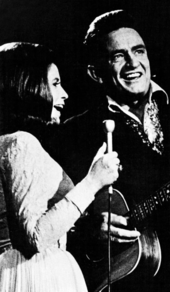Duet

A duet is a musical composition for two performers in which the performers have equal importance to the piece. It is often used to describe a composition involving two singers. It differs from a harmony, as the performers take turns performing a solo section rather than performing simultaneously. In classical music, the term is most often used for a composition for two singers or pianists. A piece performed by two pianists performing together on the same piano is referred to as "piano duet" or "piano four hands".[1] A piece for two pianists performing together on separate pianos is referred to as a "piano duo".
"Duet" is also used as a verb for the act of performing a musical duet, or colloquially as a noun to refer to the performers of a duet. The word is also occasionally used in reference to non-musical activities performed together by two people.
A musical ensemble with more than two solo instruments or voices is called trio, quartet, quintet, sextet, septet, octet, etc.
History
When Mozart was young, he and his sister Marianne played a duet of his composition at a London concert in 1765. The four-hand, described as a duet, was in many of his compositions which included five sonatas; a set of variations, two performers and one instrument, and a sonata for two pianos. The first published sonata or duet was in 1777.[2]
In Renaissance music, a duet specifically intended as a teaching tool, to be performed by teacher and student, was called a bicinium (see Étude).
In opera
Duets have always been a part of the structure of operas. Early 16th-century operas such as L'Orfeo and L'incoronazione di Poppea involve duets throughout the performance. In 17th-century Italy duets were often used in comic scenes within serious operas. In Baroque France the duet was popular in tragedies, such as songs of vengeance and confrontation. The love duet was characterized by singing in close harmonies of 3rds and 6ths, symbolizing unity after conflict.[3]
Famous operatic duets
- La clemenza di Tito by Wolfgang Amadeus Mozart
- La Cenerentola by Gioachino Rossini
- The Puritans of Vincenzo Bellini
- Don Pasquale by Gaetano Donizetti
- La traviata by Giuseppe Verdi
- Aida of Giuseppe Verdi
- Mefistofele of Arrigo Boito
- Manon Lescaut by Giacomo Puccini
- Madama Butterfly by Giacomo Puccini
- L'amico Fritz by Pietro Mascagni
In pop music
Throughout the 20th century duets have been common in the popular music of the era. Some songs were written to be heard as conversations, such as "Baby, It's Cold Outside". Others were performed around a theme, for example New York in "Empire State of Mind". Occasionally duets are an improvisation between artists, such as "Under Pressure". David Bowie and Freddie Mercury reportedly composed the lyrics in a day by improvising together.[4]
Famous pop duets
- "Baby, It's Cold Outside" - Ricardo Montalbán and Esther Williams, and with roles reversed, Red Skelton and Betty Garrett, 1948
- "Dream a Little Dream of Me" – Louis Armstrong and Ella Fitzgerald, 1950
- "I Got You Babe" – Sonny & Cher, 1965
- "Ain't No Mountain High Enough" – Marvin Gaye and Tammi Terrell, 1967
- "Jackson" – Johnny Cash and June Carter, 1967
- "Somethin' Stupid" – Frank Sinatra and Nancy Sinatra, 1967
- "Waters of March" – Elis Regina and Antonio Carlos Jobim, 1972
- "Don't Go Breaking My Heart" – Elton John and Kiki Dee, 1976
- "You're The One That I Want" – John Travolta and Olivia Newton-John, 1978
- "Dead Ringer for Love" – Meat Loaf and Cher, 1981
- "Endless Love" – Diana Ross and Lionel Richie, 1981
- "Under Pressure" – Queen and David Bowie, 1981
- "Ebony and Ivory" – Paul McCartney and Stevie Wonder, 1982
- "Islands in the Stream" – Kenny Rogers and Dolly Parton, 1983
- "Don't Give Up" – Kate Bush and Peter Gabriel, 1985
- "(I've Had) The Time of My Life" – Bill Medley and Jennifer Warnes, 1987
- "Scream/Childhood" – Michael Jackson and Janet Jackson, 1995
- "Tell Him" – Barbra Streisand and Celine Dion, 1997
- "I'm Your Angel" – R. Kelly and Celine Dion, 1998
- "When You Believe" – Whitney Houston and Mariah Carey, 1998
- "Where You Are" – Jessica Simpson and Nick Lachey, 2000
- "I Belong to You (Il ritmo della passione)" – Eros Ramazzotti and Anastacia, 2006
- "Beautiful Liar" – Beyoncé and Shakira, 2007
- "No Estamos Solos" – Eros Ramazzotti and Ricky Martin, 2007
- "Ta Voix (The Calling)" – Jennifer Paige and Lââm, 2008
- "Empire State of Mind" – Jay-Z and Alicia Keys, 2009
- "Limpido" – Laura Pausini and Kylie Minogue, 2013
- "Hurt You" – Toni Braxton and Babyface, 2014
References
- ↑ Christensen, T. (1999). "Four-Hand Piano". Journal of the American Musicological Society, 52(2) 255–298
- ↑ Miller, H.-M. (1943). The Earliest Keyboard Duets. The Musical Quarterly, 29(4), 438–457.
- ↑ Tilmouth, Michael. "Duet". Grove Music Online. Retrieved 2014-10-12.
- ↑ "The Making of Queen and David Bowie's 1981 Hit "Under Pressure": Demos, Studio Sessions & More". www.openculture.com. Retrieved 2015-01-10.
 Chisholm, Hugh, ed. (1911). "Duet". Encyclopædia Britannica (11th ed.). Cambridge University Press.
Chisholm, Hugh, ed. (1911). "Duet". Encyclopædia Britannica (11th ed.). Cambridge University Press.
External links
 The dictionary definition of duet at Wiktionary
The dictionary definition of duet at Wiktionary
